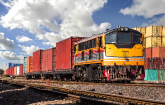Greenbrier urges action; recent train derailments, Lac-Megantic findings underscore need for safer tank cars now
~ Safer tank cars are available; customers are responding
~~ Investments in additional tank car retrofit capacity are underway
LAKE OSWEGO, Ore., Oct. 9, 2014 /PRNewswire/ -- The Greenbrier Companies, Inc. (NYSE:GBX) continued its call for prompt regulatory action to require safer tank cars, in response to recent freight train derailments involving flammable liquids.
"Recent derailments, including the derailment in Saskatchewan on Tuesday, and the findings of the Quebec coroner related to the tragic death of 47 people in the Lac-Megantic accident underscore the urgency of taking concrete actions to improve tank car design for both newly-built tank cars and for tank cars currently in service," William A. Furman, Chairman and CEO of Greenbrier said. "The fact that the accident in Saskatchewan resulted in a fire and the evacuation of local homes, even though the derailed cars in the train were not carrying crude oil, also demonstrates why enhanced safety standards should apply to all tank cars containing flammable liquids - not just those carrying crude oil and ethanol. Ultimately the rail industry should transition all hazardous materials to a more robust tank car—regardless of the flash point at which these materials ignite."
"As recent derailment events have illustrated, the urgency of upgrading the safety of the North American tank car fleet is obvious. Suggestions that industry requires six, seven or even up to 10 years to fully enhance the puncture resistance of tank cars are simply wrong. The rail supply industry can move faster than that and we will. Greenbrier and others are already making necessary investments to address this need," Furman added.
Greenbrier supports PHMSA's proposed "Option 2" design for new tank cars in flammable service built after October 1, 2015. Greenbrier was the first to announce plans to design a tank car with these specifications, which Greenbrier calls the "Tank Car of the Future," and plans to double its production capacity for new tank cars over the next 12 months to meet surging demand. In addition, through GBW Railcar Services, LLC, a newly-launched 50/50 railcar repair joint venture with Watco Companies, LLC for retrofitting and repairing railcars, Greenbrier supports PHMSA's effort to retrofit the existing fleet of tank cars currently used in the transport of all flammable commodities. GBW agrees with PHMSA that every packing group classification—PG I, II and III—within the Class 3 flammables category must be transported in a retrofitted tank car by 2020, an aggressive but achievable timeline.
In recent comments filed with the Pipelines and Hazardous Materials Safety Administration (PHMSA), Greenbrier has also recommended the agency close a loophole that presents an unacceptable public safety risk by permitting the transportation of Class 3 flammable liquids in blocks of 19 or fewer legacy tank cars that PHMSA otherwise deems unsafe. Greenbrier has suggested that PHMSA focus on the commodities being transported in determining the car type to be utilized and not on the number of tank cars in a train set.
"U.S. Secretary of Transportation Anthony Foxx has stated his commitment to finalize new regulations related to flammable liquids transported by tank cars as soon as possible. Transportation Canada has taken the lead by adopting new tank car standards earlier this year and moving forward to establish an even higher standard soon. A similarly prompt decision in the U.S. will provide industry with the regulatory certainty it needs to continue investments already underway to produce more robust tank cars. We urge the Secretary and Acting PHMSA Administrator Butters to act no later than the end of 2014 and then move quickly to harmonize the U.S. standards with new Canadian rules to create a unified North American tank car standard," Furman concluded.
Greenbrier's Tank Car of the Future is designed for safer transportation of crude, ethanol and other flammables in North America as well as use with other hazardous materials traffic. The car has advanced safety features which include a 9/16"-thick steel tank shell, more robust top and bottom outlet protection and jacketed shells with thermal protection. These new design features combine to inhibit discharge of contents during a derailment, to reduce penetration of the tank shell and to slow "pool fires" that can result when hazardous contents of a tank car escape in a breach and are ignited. The new design will also be equal in capacity volume to the legacy DOT-111 tank car with a loading volume of 30,000 gallons.
Conditional Probability of Release (CPR) measures the likelihood of tank car spills in the event of a derailment at different speeds and by different car types. With the Tank Car of the Future design, at a derailment speed of 50 mph, CPR performance improves by up to 8 TIMES versus the majority of tank cars now operating in hazardous service in the North American fleet. Also when measured by CPR, the Tank Car of the Future is twice as safe as the current state-of-the-art tank car for transporting hazardous materials—a fully jacketed and insulated CPC-1232.
GBW will deliver on retrofit designs for the legacy DOT-111 tank cars that include optimally-sized pressure relief valves, head shields, top fittings protection, thermal protection and shell jackets with thicker metal for tank car exteriors. Appropriate retrofit choices permit extended service for DOT-111 tank cars in flammable liquids service and for other hazardous materials transport as these cars are placed in lower risk service over time. GBW also offers retrofit alternatives for the most recently built CPC-1232 tank cars, with features including enhancements to the bottom outlet valve and pressure relief valves that will reduce the likelihood of tank cars releasing contents in derailments. Combined, these retrofits meaningfully improve the safety performance of all tank car types in continued service.
About Greenbrier
Greenbrier, (www.gbrx.com), headquartered in Lake Oswego, Oregon, is a leading supplier of transportation equipment and services to the railroad industry. We build new railroad freight cars in our 4 manufacturing facilities in the U.S. and Mexico and marine barges at our U.S. manufacturing facility. Greenbrier also sells reconditioned wheel sets and provides wheel services at 9 locations throughout the U.S. We recondition, manufacture and sell railcar parts at 4 U.S. sites. Greenbrier is a 50/50 joint venture partner with Watco Companies, LLC in GBW Railcar Services, LLC which repairs and refurbishes freight cars at 38 locations across North America, including 14 tank car repair and maintenance facilities certified by the Association of American Railroads. Greenbrier builds new railroad freight cars and refurbishes freight cars for the European market through our operations in Poland. Greenbrier owns approximately 8,600 railcars, and performs management services for approximately 238,000 railcars.
About GBW
GBW is a joint venture between The Greenbrier Companies, Inc. and Watco Companies, LLC ("Watco") formed in June 2014. Greenbrier is one of the leading designers, manufacturers and marketers of railroad freight car equipment in North America and Europe. Watco is one of North America's largest short line railroad operators, and provides terminal and port services to a variety of industries, including crude oil and ethanol transloading, and fleet management services. GBW owns and operates the railcar repair, refurbishment, and maintenance businesses formerly operated separately by Greenbrier and Watco. GBW is the largest independent railcar repair shop network in North America. The company operates 38 railcar repair, refurbishment and maintenance shops, including 14 repair shops specializing in tank car repairs that are certified by the Association of American Railroads for such work. The company can repair, maintain, qualify and retrofit tank cars.
"SAFE HARBOR" STATEMENT UNDER THE PRIVATE SECURITIES LITIGATION REFORM ACT OF 1995: This press release may contain forward-looking statements, including statements regarding expected new railcar production volumes and schedules, expected customer demand for the Company's products and services, plans to increase manufacturing capacity, restructuring plans, new railcar delivery volumes and schedules, growth in demand for the Company's railcar services and parts business, and the Company's strategic initiatives and future financial performance. Greenbrier uses words such as "anticipates," "believes," "forecast," "potential," "goal," "contemplates," "expects," "intends," "initiatives," "targets," "plans," "projects," "hopes," "seeks," "estimates," "could," "would," "will," "may," "can," "designed to," "foreseeable future" and similar expressions to identify forward-looking statements. These forward-looking statements are not guarantees of future performance and are subject to certain risks and uncertainties that could cause actual results to differ materially from in the results contemplated by the forward-looking statements. Factors that might cause such a difference include, but are not limited to, reported backlog is not indicative of our financial results; turmoil in the credit markets and financial services industry; high levels of indebtedness and compliance with the terms of our indebtedness; write-downs of goodwill, intangibles and other assets in future periods; sufficient availability of borrowing capacity; fluctuations in demand for newly manufactured railcars or failure to obtain orders as anticipated in developing forecasts; loss of one or more significant customers; customer payment defaults or related issues; actual future costs and the availability of materials and a trained workforce; failure to design or manufacture new products or technologies or to achieve certification or market acceptance of new products or technologies; steel or specialty component price fluctuations and availability and scrap surcharges; changes in product mix and the mix between segments; labor disputes, energy shortages or operating difficulties that might disrupt manufacturing operations or the flow of cargo; production difficulties and product delivery delays as a result of, among other matters, changing technologies, production of new railcar types, or non-performance of subcontractors or suppliers; ability to obtain suitable contracts for the sale of leased equipment and risks related to car hire and residual values; difficulties associated with governmental regulation, including environmental liabilities; integration of current or future acquisitions; succession planning; all as may be discussed in more detail under the headings "Risk Factors" and "Forward Looking Statements" in our Annual Report on Form 10-K for the fiscal year ended August 31, 2013, and our other reports on file with the Securities and Exchange Commission. Readers are cautioned not to place undue reliance on these forward-looking statements, which reflect management's opinions only as of the date hereof. Except as otherwise required by law, we do not assume any obligation to update any forward-looking statements.
SOURCE The Greenbrier Companies, Inc. (GBX)
WANT YOUR COMPANY'S NEWS FEATURED ON PRNEWSWIRE.COM?
Newsrooms &
Influencers
Digital Media
Outlets
Journalists
Opted In





Share this article